2.Word Division
word域功能详解1

word域功能详解1 D用途:将段落顺序编号。
选项:开关说明:\s 定义分隔字符(2)AutoNumLgl域语法:{ AUTONUMLGL [Switches] }用途:对法律和技术类出版物自动进行段落编号。
选项:开关意义:\e 显示无句点的法律式编号(3)AutoNumOut域语法:{ AUTONUMOUT }用途:自动以大纲样式对段落进行编号。
(4)Barcode域语法:{ BARCODE \u "LiteralText" 或Bookmark \b [Switches ] }用途:插入邮政条码(美国邮政局使用的机器可读地址形式)。
它既可以插入POSTNET(收信人点条码),也可以插入“外表识别标记”(或称为FIM)。
选项:指令意义:"LiteralText" 或Bookmark 收信人地址和邮政编码。
后面跟\b开关时,书签可以替代LiteralText。
另外,LiteralText也可以是嵌套域的结果开关说明:\b 前接一个书签时,使用书签定义的地址中的邮政编码信息\f "letter" 插入“外表识别标记”(FIM),由字母指定回邮标记的类型:"A"插入一个礼节性回邮标记;"C" 插入一个商业回邮标记。
要打印FIM-A和FIM-C标记,必须有POSTNET 条码\u 表示条码是美国的邮政地址(5)Bookmark和Ref域语法:{ [REF] Bookmark [Switches] }用途:插入指定的书签所代表的文字或图形,而且活动文档中必须有该书签的定义。
要插入其他文档中的用书签标记的文字或图形,可以使用INCL?PICTURE或INCL?TEXT域。
选项:指令意义:Bookmark 书签名。
如果书签所标记的文字包含段落标记,则BOOKMARK域之前的文字将使用书签中段落的格式开关说明:\f 增加书签所标记的脚注、尾注或批注序号并插入对应的注释或批注文字\h 创建到用书签标记的段落的超级链接\n 域将以无后续句点形式显示交叉引用段落的完整的段落编号\p 使域使用“见上方”或“见下方”形式显示其相对于源书签的位置\r 将书签标记段落的无后续句点形式的完整段落编号插入相关文字或相对于编号方案中的位置\t 与\n、\r 或\w开关连用时,使REF域屏蔽非分隔符或非数字文字\w 插入用书签标记的段落的段落编号,此编号会反映该段落在文档全部上下文中的位置(6)ListNum域语法:{ LISTNUM "Name" [Switches] }用途:在段落中的任意位置插入一组编号。
Chapter 1 Manuscript Form

Contents 目录
1. Arrangement 2. Word division 3. Capitalization 4. Handwriting
1. Arrangement
(1)Leaving the margins ■ two centimeters at the top ■ two centimeters at the bottom ■ one and a half centimeters on the left ■ one and a half centimeters on the right (2)Paragraphing ■ Double spaced( write on each other line) ■ Vertical line to mark the LEFT margin
Attention !
1. Never begin with a comma(,), a period(.), a colon(:), a question mark (?), an exlamation mark(!) 2. Never ends with 【 “ ( -
THANK YOU!
Article
a/an/the
Preposition of/in/at/on…
Coordinating conjunctions and/or/but….
Infinitives to+…
(But: the first or the last word of the title)
(虚小实大: 虚词小写(虚词出现在第一位时除外),实词大写)
3. Capitalization
■ proper names ■ key words in titles ■ the first words of sentences ■ The use of capital letters and punctuation in quoted words and
Manuscript Form and Punctuation
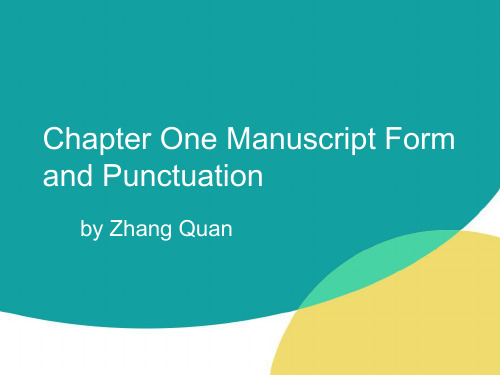
a single letter cannot be put at the end/beginning of a line: e· voke
a two-letter ending should not be put at two syllable words with double the beginning of a line: hand· ed consonants in the middle are as a rule divided between two consonants: strug· gle Divisions that may mislead the reader/of proper names should be avoided: re· ally
Task 2 Punctuate the following passages
1. most american people are fond of cats and or dogs it is said that every year they spend about $5.4 billion on their pets including $1.5 billion on pet food four times the amount of money they spend on baby food now there are about 100 million dogs and cats in the country the number is still going up rapidly since 12 500 puppies are born every hour
Task 1 Capitalize the following titles
5. Division (for class)
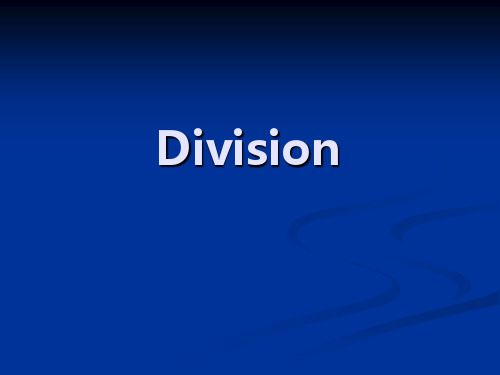
点评
英语很多句子中的某个词语,尤其是副词,看上去是 修饰与其相邻的某个成分,但实际上是对整个句子所 陈述的内容进行描述、评述或评价。如本句中 curiously是评述整个句子所描述的情况。
在将该句翻译成汉语时,可以采用两种方法: 1、将该副词的意思先翻译出来,放到句首[译文一]; 2、将句子所讲述的内容先呈现出来,然后再将副词翻 译出来[译文二]
Discussion
1. He had left a note of welcome for me, as sunny as his face. 他留下一封短信对我表示欢迎,那封信写得热情洋溢, 一如其人。 2. Why did they want a new leader? Partly it was because they deeply felt that Mr. Heath, for all his many qualities, was a born loser. 他们为什么想换一换领袖?有一部分原因是他们深切 地感到,尽管希思先生有许多优良品质,他却是个 天生的败将。 (for all )尽管,虽然
(一)单词的分译 Division of a word
1、形容词拆分
You are talking delightful nonsense. 你虽信口胡扯,倒也蛮有情趣。
点评:形容词delightful拆分成句。
1、形容词拆分
He crashed down on a protesting chair. 他猛然坐到一把椅子上,椅子被压得吱吱作响。 Chairman Mao might have spoken with understandable pride of the policy of “selfreliance.” 毛主席在谈到“自力更生”的政策时,也许有些 自豪感,这是可以理解的。
writing(word division)
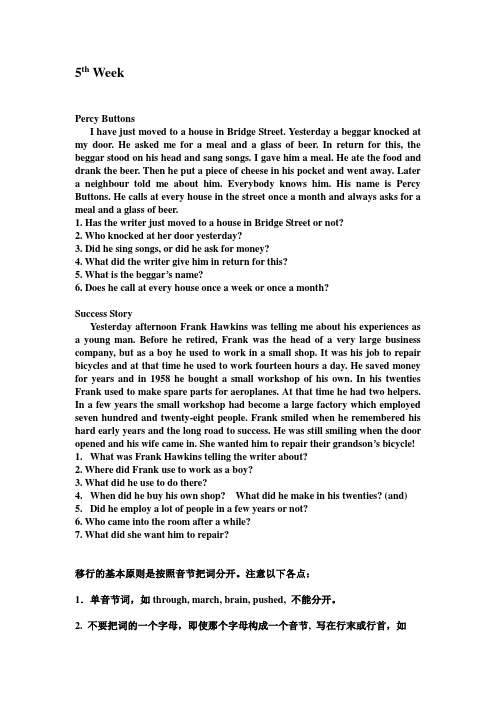
5th WeekPercy ButtonsI have just moved to a house in Bridge Street. Yesterday a beggar knocked at my door. He asked me for a meal and a glass of beer. In return for this, the beggar stood on his head and sang songs. I gave him a meal. He ate the food and drank the beer. Then he put a piece of cheese in his pocket and went away. Later a neighbour told me about him. Everybody knows him. His name is Percy Buttons. He calls at every house in the street once a month and always asks for a meal and a glass of beer.1. Has the writer just moved to a house in Bridge Street or not?2. Who knocked at her door yesterday?3. Did he sing songs, or did he ask for money?4. What did the writer give him in return for this?5. What is the beggar’s name?6. Does he call at every house once a week or once a month?Success StoryYesterday afternoon Frank Hawkins was telling me about his experiences as a young man. Before he retired, Frank was the head of a very large business company, but as a boy he used to work in a small shop. It was his job to repair bicycles and at that time he used to work fourteen hours a day. He saved money for years and in 1958 he bought a small workshop of his own. In his twenties Frank used to make spare parts for aeroplanes. At that time he had two helpers. In a few years the small workshop had become a large factory which employed seven hundred and twenty-eight people. Frank smiled when he remembered his hard early years and the long road to success. He was still smiling when the door opened and his wife came in. She wanted him to repair their grandson’s bicycle!1.What was Frank Hawkins telling the writer about?2. Where did Frank use to work as a boy?3. What did he use to do there?4.When did he buy his own shop? What did he make in his twenties? (and)5.Did he employ a lot of people in a few years or not?6. Who came into the room after a while?7. What did she want him to repair?移行的基本原则是按照音节把词分开。
compound-complex
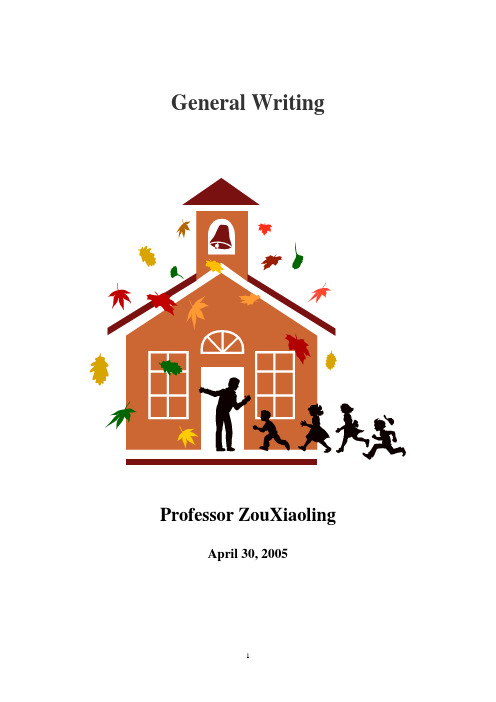
General WritingProfessor ZouXiaolingApril 30, 2005Teaching Plan for WritingParticipants: Third-year StudentsTime: 9/2003-6/2004General Goals or Objectives:▼try to improve students’ writing ability through classes and writing materials▼Students acquisition of the skills involved through writing practice▼Enlarge students’ horizon in writing through reading, translating and writing practiceMajor Task of each Semester◆the first term: basic writing◆the second term: applied writingI. the basic writing rules●Manuscript Form: When we write we should work carefully, write neatly and clearly; proofread it once or twice.1. Arrangement: How do we write the title? Where, what kind of words, punctuation rules.2. Word Divisi on rules: Who’d like to list the word division rules in writing? When do it, pay attention tosyllables and the form of the word.3. Capitalization rules: When do we use capitalization?4. Punctuation (for general rules): What kinds of Punctuations are usually used in writing?5. Handwriting:1> What should we do when we want to cross out a word?2> What should we do when we write a word in wrong spelling:3> What should we do when we want to add a word:4> Write letters clearly:●Diction (the choice and use of words)1. Words1> levels of words:2> meaning of words:3> general and specific words:2. Idioms:3. Figures of speech:●The Sentence1. Complete sentences and sentence fragments:2. Types of Sentences.1>According to their use, sentences can be divided into declarative, interrogative, imperative and exclamatory ones.2>According to the structure, sentences can be divided into simple, compound, complex and compound-complex ones.3>Short and long sentences.3. Effective sentences.1> Unity:2>Coherence:3> Conciseness:4> Emphasis:The Paragraph1. Effective paragraphs:(1) Unity:(2) Coherence:(3) Transition:2. Ways of developing paragraphs.1> Development by time.2> Development by process.3> Development by space.4> Development by example or generalization.5> Development by comparison and contrast.6> Development by cause and effect.7> Development by classification.II . Steps in Writing a Composition1. Use the example “The Sc hool Library” to explain the following point.1. Assemble your ideas:2. Work out your thesis3. Make an outline4. Write the First Draft5. Revise the First Draft6. Making the Final Copy2. Exercises:Suppose the topics assigned are:1. Chinese young people of the 20th century2. A familiar professor (Our English teacher)3. Appearances are deceptiveA. Write down 12~15 relevant points.B. According to the points you have written, formulate three possible theses.C. Choose one thesis which you consider most suitable.D. Work out an outline.II. Organizationment on students’ exercisesanization1.Some Principles: 1) Unity: 2) Coherence: 3) Richness: 4) Proportion:2.The beginning: give students some sentence patterns to begin a composition3.The End: give students some sentence patterns to end a composition3. Exercise:1) Write a beginning paragraph using any of the sentence patterns listed above for one of the following topics:● 1. College Education; 2. Private Schools; 3. The importance of self-education; 4. Premature Preschool Education● 1. Morality and Education; 2.Two Educational Patterns; 3. Children’s Education; 4. Students’ part-time jobs;5. The Changing Criteria of a Good Student;6. Studying Abroad;7. Psychological Health● 1. Can Test Tell the Whole Story; 2. On Cheating in Examinations; 3. On grading system; 4. On Test and Test Cheating; Should Class Attendance be Required● 1. A Good Teacher; If I were a Teacher● 1. Social Practice; 2. Social activities and our study; 3. Make Full Use of School Days; 4. The Impact of Commercial Awareness on Higher School Education● 1. Youth is a Golden Age; 2. Preciousness of Time; 3. The value of Time● 1. Failure and Success; 2. On Failure; 3. Key Factors to Success● 1. It is Never Too Old to Learn; 2. On Diligence; 3. Fair Competition● 1. Books and Teenagers; 2. The Importance of Extensive Reading; 3. The Good of Reading Books; 4. Reading Makes a Full Man● 1. Work and Recreation; 2. Recreation; 3. Work and Play; 4. How to Spend Leisure Time; 5. Holiday Ideas are Changing; 6. Interests; 7. Hobbies; 8.Teacher Doing Business; 9. Music● 1. The Right Use of Money; 2. Temptation; 3. Talent and Wealth; 4. Wealth and Happiness; 5. Things Making Life Happy● 1. The One Child Family; 2. Overpopulation; 3. China’s Unem ployment Today; 4. The Career I Pursue; 5. Birth Control: Key to China’s Development● 1. On Open Policy; 2. The Importance of Agriculture; 3. China’s Market Economy; 4. Combating Fake Goods; 5. The Favorable Effects of Tourism; 6. Business Ethics● 1. Discount; 2. Is TV a Plus or a Minus; 3. Pets; 4. TV Shopping; 5. News Media; 6. Different Social Customs Between Americans and Chinese; 7. Liberty; 8. Mercy Killing (Euthanasia); 9. Video Games; 10. Shortening Work week● 1. Fast Food in China; 2. Fast-Food Restaurants● 1. Man and Environment; 2. How to Save the Wild; 3. Why Do Some Animals Die Out; 4. The Advantages and Disadvantages of Tall Buildings; 5. World’s Urbanization; 6. Housing Problems in Cities; 7. Preserving the Environment; 8. Make Cities Greener; 9. Copyright; 10. Intellectual Property Right; 11. Culture Shock; 12. Globalization● 1. What Modern Sports Bring About; 2. Participating is Most Important; 3. How to Keep Fit; 4. How to Get Rid of Bad Habits● 1. The importance of Science and Technology in Modern Life; 2. Science and Human Life; 3. Science and the Problem in the World; 4. Hopes and Fears of the Future; 5. Computer Technology● 1. Water Resources; 2. Natural Resources; 3. China’s Energy; 4. Solar Energy; 5. Energy Crisis; 6. An Effective Way to Conserve Resource---Recycle● 1. Thrift; 2. Honesty; 3. Modesty; 4. Patriotism; 5. Patience; 6. The Importance of Confidence; 7. Creativity ● 1. Talent and Diligence; 2. Diligence and Success; 3. Competition and Cooperation; 4. Choosing the Right Career; 5. Career Planning● 1. Love; 2. Love and Marriage; 3. My View on Family; My Home● 1. Opportunity and Success; 2. Fate; 3. Opportunity; 4. My View on Opportunity● 1. The origin of the Dragon Boat Festival; 2. The Most Memorable Day in My Life; 3. My father (or Mother);4. A Friend in My Memory;5. My First Day on the Campus2) Write an ending paragraph using any of the sentence patterns listed above for one of the following topics:● 1. College Education; 2. Private Schools; 3. The importance of self-education; 4. Premature Preschool Education● 1. Morality and Education; 2.Two Educational Patterns; 3. Children’s Education; 4. Students’ part-time jobs;5. The Changing Criteria of a Good Student;6. Studying Abroad;7. Psychological Health● 1. Can Test Tell the Whole Story; 2. On Cheating in Examinations; 3. On grading system; 4. On Test and Test Cheating; Should Class Attendance be Required● 1. A Good Teacher; If I were a Teacher● 1. Social Practice; 2. Social activities and our study; 3. Make Full Use of School Days; 4. The Impact of Commercial Awareness on Higher School Education● 1. Youth is a Golden Age; 2. Preciousness of Time; 3. The value of Time● 1. Failure and Success; 2. On Failure; 3. Key Factors to Success● 1. It is Never Too Old to Learn; 2. On Diligence; 3. Fair Competition● 1. Books and Teenagers; 2. The Importance of Extensive Reading; 3. The Good of Reading Books; 4. Reading Makes a Full Man● 1. Work and Recreation; 2. Recreation; 3. Work and Play; 4. How to Spend Leisure Time; 5. Holiday Ideas are Changing; 6. Interests; 7. Hobbies; 8.Teacher Doing Business; 9. Music● 1. The Right Use of Money; 2. Temptation; 3. Talent and Wealth; 4. Wealth and Happiness; 5. Things Making Life Happy● 1. The One Child Family; 2. Overpopulation; 3. China’s Unemployment Today; 4. The Caree r I Pursue; 5. Birth Control: Key to China’s Development● 1. On Open Policy; 2. The Importance of Agriculture; 3. China’s Market Economy; 4. Combating Fake Goods; 5. The Favorable Effects of Tourism; 6. Business Ethics● 1. Discount; 2. Is TV a Plus or a Minus; 3. Pets; 4. TV Shopping; 5. News Media; 6. Different Social Customs Between Americans and Chinese; 7. Liberty; 8. Mercy Killing (Euthanasia); 9. Video Games; 10. Shortening Work week● 1. Fast Food in China; 2. Fast-Food Restaurants● 1. Man and Environment; 2. How to Save the Wild; 3. Why Do Some Animals Die Out; 4. The Advantages and Disadvantages of Tall Buildings; 5. World’s Urbanization; 6. Housing Problems in Cities; 7. Preserving the Environment; 8. Make Cities Greener; 9. Copyright; 10. Intellectual Property Right; 11. Culture Shock; 12. Globalization● 1. What Modern Sports Bring About; 2. Participating is Most Important; 3. How to Keep Fit; 4. How to Get Rid of Bad Habits● 1. The importance of Science and Technology in Modern Life; 2. Science and Human Life; 3. Science and the Problem in the World; 4. Hopes and Fears of the Future; 5. Computer Technology● 1. Water Resources; 2. Natural Resources; 3. China’s Energy; 4. Solar Energy; 5. Energy Crisis; 6. An Effective Way to Conserve Resource---Recycle● 1. Thrift; 2. Honesty; 3. Modesty; 4. Patriotism; 5. Patience; 6. The Importance of Confidence; 7. Creativity ● 1. Talent and Diligence; 2. Diligence and Success; 3. Competition and Cooperation; 4. Choosing the Right Career; 5. Career Planning● 1. Love; 2. Love and Marriage; 3. My View on Family; My Home● 1. Opportunity and Success; 2. Fate; 3. Opportunity; 4. My View on Opportunity● 1. The origin of the Dragon Boat Festival; 2. The Most Memorable Day in My Life; 3. My father (or Mother);4. A Friend in My Memory;5. My First Day on the CampusIII. Types of Writing1.Description: Description is painting a picture in words of a person, place, object, or scene. Give some models to explain the following.(1)Description of a personExercises:1) Read the model essays and discuss what main impressions each writer wishes to give of the person described.2) Describe a person. The person may be(1) some one you know well, such as a family member, a relative, a teacher or a classmate, a colleague or a friend;(2) some stranger who attracted your attention and made a deep impression on you;(3) some character in a book, a film or a TV show;(4) yourself.Be sure to give well chosen details of the person's appearance, character, behavior or whatever worth mentioning. Do not write in generalities but focus on one or two aspects and try to “show" by examples instead of "tell" in words --- note how Kissinger uses the example of the young interpreter to show Chinese people's love for PremierChou Enlai(2)Description of a placeExercises:1) Read the model essays and discuss the devices used by the authors, the impressions they create and the purposes of description.2) Describe a place. It may be(1) a scenic spot, a park, a garden, a theater, a market-place, a shopping center, a hotel lobby, an exhibition, a flower show, a museum, etc.;(2) a Siheyuan, a compound with houses around a courtyard, in Beijing;(3) someone's study, bedroom, living-room, kitchen, etc.3) Describe a dormitory of four students to show that A is neat and tidy and time-conscious, B is warm-hearted and loves sports, C is a careless music lover, and D is more interested in fashions than in his or her studies.(3)Description of an objectExercises:1) Read the model essay and discuss the devices the author uses and his purpose of description.2) Describe an object. It may be(1) a painting, an old photo, an article of handcraft art, a tablet, a tombstone, etc.(2) an exhibit in a museum or an exhibition, such as an unearthed artifact, a new product or household gadget;(3) an ancient Chinese invention such as the earliest compass;(4) a Pailou (a free-standing arch), or any other example of Chinese architecture;(5) a cloud pillar, a stone lion, or other examples of culture-loaded objects.(4)Description of a sceneExercises:1) Read the model essays and comment on the dominant impressions they give the reader and how these impressions are created through the setting, the people and the actions.2) Describe a scene. It may be(1) a (birthday) party, a celebration, a wedding, a demonstration, an accident, etc.(2) someone's homecoming or departure.Decide on the effect(s) you want to achieve before you begin so that your essay will include only the relevant details.3) Write a description of1. how people celebrate the Mid-autumn or Spring Festival in your home town;2. some special custom of the Han nationality or any of the minority nationalities in China.4) Choose your own topic and write a description of a person, place, object, or scene.2. Narration(1) Context(2)Selection of details(3)Organization(4)Point of view(5)PurposeExercises:I . Read the model essays carefully and discuss:1. Have the authors made clear when, where, and to whom the action in the narrative happened at the beginning?2 What is the purpose of each story?3 Are the details selected useful and effective?4. How are the events organized?5. Can the three first-person narratives be changed into third-person narratives? What are the advantages and disadvantages of the change?II. Write a first-person narrative describing1. the happiest or saddest or most memorable or most important day in your life, for example, your first day at school, the day when you were given an interview, the day when you got your first pay, the day when someone(a teacher, a friend or a colleague) walked into your life, the day when something changed the course of your life;2. an incident which has taught you something; or3. some experience you will never forget.III. Write a third-person narrative using any of the topics listed above.IV. Write a narrative telling1. the origin of zongze, the three-cornered dumpling specially eaten on the Dragon Boat Festival, or some other Chinese custom;2. the legend of the Cowherd and the Girl Weaver, the story of Liang Shanbo and Zhu Yingtai, or some well-known Chinese legend which might be of interest to foreigners.V. Choose your own topic and write a narrative.Note that some of the topics for description of a scene can also be used for narration, but the focus is different. A narrative has a plot with a beginning, a middle, and an end. If a scene can be compared to a picture, then a narrative may be compared to a motion picture. When planning your narrative, decide on your purpose and then choose details and design your plot in agreement with your purpose. Be sure to make the context quite clear at the beginning and consider also the organization and point of view.If you like, you may turn what you have written for a description of a scene into a narrative. In so doing, you may have a better understanding of the similarities and differences between the two.3. ExpositionCommonly used methods of development:1)by illustration2)by division and classification3)by comparison and contrast4)by cause and effectby definition(1)Illustration: Give some examples to illustrate the following pointExercises:1. Read the model essays and comment on the authors' selection of examples. Are there sufficient examples to illustrate the authors' points? Are the examples specific and typical? Are they relevant and interesting? How do the authors group and arrange their examples?2. Write an essay on one of the following topics:(1) College Students' Everyday Expenses Are High(2) Changes in My Home Town or Beijing in the Last ... Years or since .(3) Life on Campus Is Interesting (or Monotonous)(4) There Is a Generation Gap(5) Sunday Is the Busiest Day of the Week to Me or to Many Chinese(6) What the Service Trades Can Do for Us3. Write an illustration paper discussing the feudalistic thinking of some young people today. You may start by considering some of the points listed in the article below. Give specific and typical examples to illustrate your point(s).青年人也有封建思想封建制度在我国长达数千年之久。
Chapter1文稿格式和标点1ManuscriptForm文稿格式
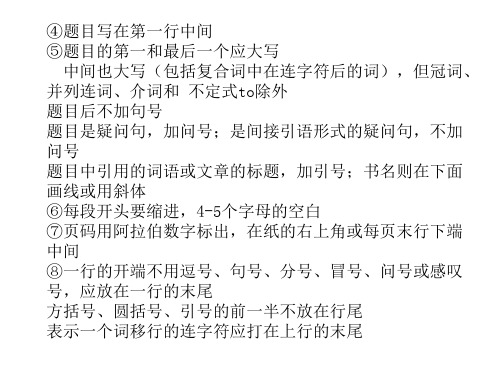
Chapter 1 文稿格式和标点 2 Word Division移行 ①单音节词不分开,双或多音节词按音节分 ②辅音+le看作一个音节 ③不要把词的一个字母写在行末或行首 ④不要把只有两个字母的音节写在行首 ⑤注意分开后会造成误解 ⑥带连字符的复合词只可在连字符处分开 ⑦双音节词有重复的辅音字母,在这两个字母间分开
⑵有时在表示愿望的口号之后
7 Quotation Mark 引号 ⑴不论是对话还是引文,直接引语的两端用双引号 ⑵引语中的引语用单引号 ⑶间接引语不用引号 ⑷文章、短篇故事、短诗及歌曲等的题目 书中各章节的题目 书刊名称应用斜体或字下线标明 ⑸有特殊意义的词有时用引号括起来
⑹引号与其它标点配合使用
3. sister-in-law
11. dictatorship
4. handy
12. far-reaching
5. correctness
6. gratitude
7. bonus
8. permission
现在的趋势是不加,尤其是团体、通讯社和广播电台 后
⑶稍稍分开的三个句号就成了省略号,表示在引语中 省略了一个或更多的词 也可表示说话停顿或迟疑 如在一句末用省略号,后还要加句号
3 The Semicolon分号 ⑴两个并列从句之间不用连词,则用分号
⑵起联系作用的副词,如however,、、、等,不应用 作连词来连接并列从句,之间用分号而不用逗号
5 The Question Mark问号 ⑴用在直接问句后,但间接问句后不用
⑵陈述句和祈使句被用作问句时(用升调)
⑶放在括号内的问号表示不能肯定它前面的词、数字 或日期的准确性
6 The Exclamation Mark感叹号 ⑴用于感叹句以及抒发某种强烈感情的感叹词或短 语之后
英语写作基础教程(第三版)chapter
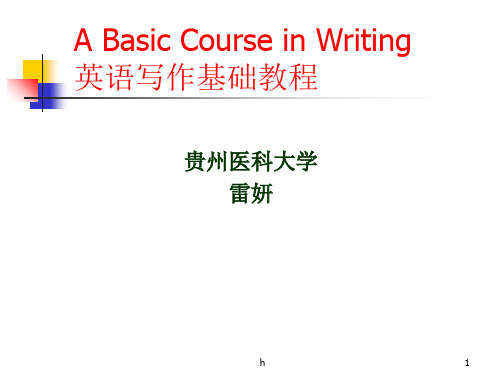
and a few books - are here. (4). introduce a summarizing clause after a series of
h
11
一、Manuscript Form
1. Arrangement
(10) attention: Never begin with a comma(,), a period(.), a colon(:), a question mark (?), an exclamation mark(!)
Never ends with 【 “ ( h-
h
20
二、 Punctuation
3. The Dash / Hyphen (-)
(1). indicates a break in thought or a change in tone, or a speaker's confusion or hesitation e.g. Many people went there - did you go?
2. The Period (.)
(1). used at the end of a declarative sentence, a mildly imperative sentence, and an indirect question
(2). Abbreviations U.S.A. a.m.
(3). Three spaced periods make the ellipsis mark
Manuscript Form and Punctuation(英语标点符号用法)
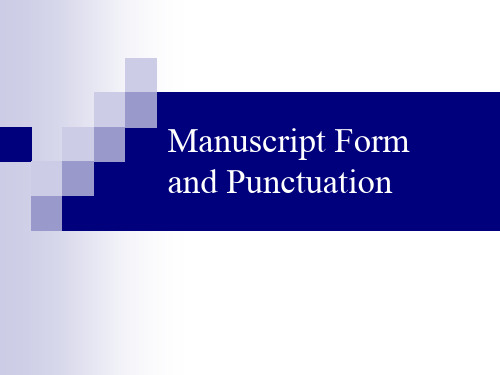
The last word of a page should not be divided. It should be written on the next page. Division of words at the ends of several consecutive lines should be avoided.
Manuscript Form and Punctuation
I. Manuscript Form
1. Arrangement 1) When we write an essay to be read by the teacher, we should write on every other line so that there will be room for corrections. It is necessary to leave a margin of about two centimeters at the top and the bottom of the page, and one of a centimeter and a half on the right and left side.
if the quoted sentence is put before the subject
and verb of saying, it ends with a comma, and
the verb of saying is followed by a full stop;
if the quoted words are a phrase instead of a corase is treated as part of the whole sentence.
英语写作基础教程(1)

第 二 章 用 词 (Using Proper Words)
第三章造句
(Making Correct and Effective Sentences)
第四章
段 落 (Developing Paragraphs)
第 六 章 完 整 的 作 文 (Composing Essays)
第七章 应用文(Writing for Practical Purposes)
Chapter one
Manuscript Form and Punctuation 1. why is it important to write in correct
manuscript? 2. What are the rules for titles?
Focus 1 Manuscript Form (P1)
学习方法例举
根据自己的情况,选择不同的学习方式: 方式一:如果你能够写出语法基本正确的句子和
段落,那么,你就可以直接开始学习第六章(完整的 作文)或第七章(应用文写作)。将前面四章的学习 内容作为自学内容,如:标点符号的运用、信件的格 式等;
方式二:如果还没有自信能写出语法基本正确的 句子和段落的同学,可以从第一章开始逐章学习。基 础学习准备好后,对教学重点的内容也就容易把握了。
教学重点
1. 第六章“短文的写作” (Composing Essays) 2. 第七章“应用文的写作” (Writing for Practical Purposes)
巴基斯坦驻华大使鸿德致辞
非常感谢院长先生。谢谢您做介绍时的友好言辞。今天我们很 高兴来到这里。我夫人与我为有这次机会再次来到贵校访问感到 荣幸。感谢贵校对我们的欢迎,特别感谢鸿德学院的热情接待, 我们为此感到不胜荣幸,谢谢你们,我们此行带来了大使馆统和 巴基斯坦人民的良好祝愿。
英语写作基础教程(第三版)Chapter 1

一、Manuscript Form
1. Arrangement 2. Word division 3. Capitalization 4. Handwriting
一、Manuscript Form
Answers to task 1
1. 2. 3. 4. 5.
6.
Where I Lived, and What I Lived For Are Transgenic Crops Safe? Well-Known Dramatists of the Ming Dynasty A Day to Remember Approaches to Teaching English as a Foreign Language Criticisms on the Ending of Mark Twain‟s Adventures of Huckleberry Finn
二、 Punctuation
1. The Comma (,)
(1). A comma is used to join clauses. It is put before the conjunction (and, but, or, for, so, nor, yet ) (2). A comma is used after an adverbial clause or phrase. (3). Commas are used to separate a series of words or phrases with the same function in the sentence.
一、Manuscriptnt (title)
新Part 1 Manuscript Form
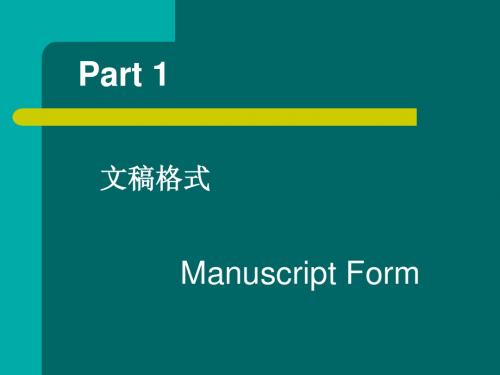
1.Margins
Leave a margin on each side of the paper two —about ______centimeters at the top and a centimeter and a half ___________________ at the left, the right and the bottom.
X
II. Word Division
3.
Do not separate proper names.
eg. China, Austen
Hale Waihona Puke 4. 5.Divide hyphenated words at the hyphen.
eg. father-in-law, empty-handed
Divide prefixes or suffixes from the base part of the word.
Exercise: Capitalize the following titles
(8) getting to know the world outside the campus (9) the advantages and disadvantages of college students’ taking a part-time job (10) the myth of a negro literature (11) Dickens and David Copperfield (12) is it worthwhile to probe the outer space (13) what reform means to China
Avoid Comma Fault 避免逗号错
Lecture 2 manuscript form 《英语写作手册》丁往道编 外研社

★ Do not begin a line with a comma, a period, etc.
★ Do not end a line with the first half of a pair of brackets, quotation marks, or parentheses.
Summary—Arrangement
11.capitalize v. ['kæpɪtəlaɪz]
12.capital n.
13. lower v.
14. lowercase n. [,ləʊə'keɪs]
标点符号 并列连词
大写 大写字母
小写 小写字母
I. Arrangement
1.Margin 2.Indentation 3.Punctuation
II.Handwriting Principles of Handwriting
1. Write clearly, neatly and legibly. 2. Clearly distinguish between capitals
Excercise
Find out what is wrong in the manuscript form of the following paragraph.
For city dwellers, dragon lanterns can be seen only on grand ceremonies on TV. In my hometown, however , putting on a dragon latten show is a very popular per -formance. To celebrate the Spring Festival, many villages make preparations for the dragon lantern show( special food, religious sacrifice…).
英语写作教程(第一册)课件L1-2 manuscript form
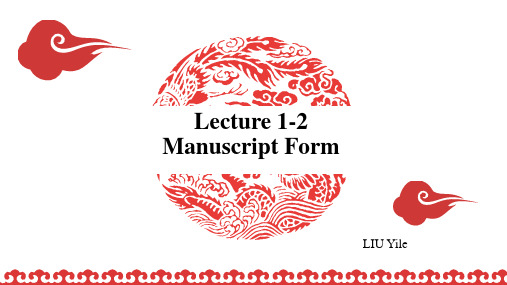
Proper nouns are the names of specific people, places, or things.
1. Names and nicknames of people 2. Names of particular places
John F. Kennedy, Stonewall Jackson Asia, the U.S.A., the Great Lakes
4. Use numerals more than two words long.
The largest commercial bank today may offer over 200 separate financial services.
Note: When one number immediately precedes another in a sentence, spell out the first, and use a numeral for the second. two 11-year cycles
3.Capitalize names that show family relationship.
Will you come with me, Granny? Thank you, Father.
4. Capitalize proper nouns and their abbreviations;
➢ “My trip to Mount Tai,” he said, “was interesting lize opening and closing of a letter.
Dear Sir: Sincerely yours,
Dear Mr. Carpenter: Truly yours,
英语写作手册part 1 manuscript form

2. Capitalization
Three Conditions:
the first words of sentences key words in titles
proper names
2. Capitalization (Exception 1)
Capitalize the first word of every sentence — unless that sentence is in parentheses incorporated within another sentence. E.g. Glacial till or debris (some geologists call this material
Never end a page with a hyphen (7);
There is natural gap between affixes and double consonants (8,9);
If not sure, consult a dictionary or write the whole
3.
I went with my mom and dad to visit my aunt
and uncle.
Capitalize the names of family relations when they are used as substitutes for names or they are a part of the names:
How to
leave margins? write a title?
indent the first line of each paragraph?
Chapter1 Manuscript Form and Punctuation
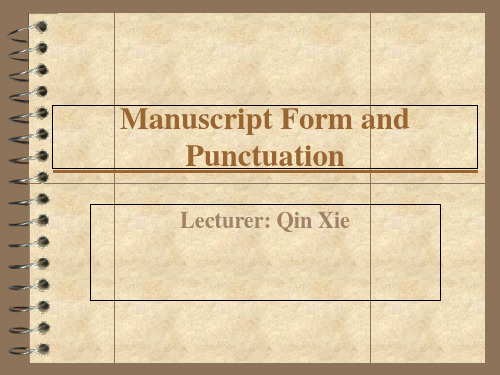
Lecturer: Qin Xie
Manuscript Form
1. Arrangement 2. word division 3. Capitalization 4. Handwriting
Principles of Arrangement
count, health and thought. 2) two or more syllables can be divided according
to the formation of syllables. E.g. re/ peat/ed, in/sist, punc/tual, ect. 3)a stressed close syllable usually takes a consonant with it: ded/i/cate, grat/i/fy, and fin/i/sh 4) a consonant plus –le is treated as a syllble: min/gle, goo/gle, no/ble 5) a single letter sh
The Yangtze River, The National Day, The Lantern Festival, ect. Words derived From proper names Eg: Maxist, Taoist, Confucism,Darwinism ect.
All sentences, including sentence fragments treated as sentences, should begin with capital letter.
(Wiedmann, Hennigs, Siebels / Measuring Consumers‘ Luxury Value Perception: A Cross-Cultural Framework,2007)
Manuscript Form and Punctuation(英文标题大小写及标点符号使用)
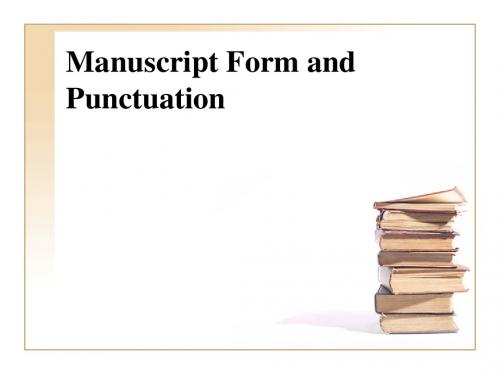
2. A comma is used after an adverbial clause or phrase (including a prepositional phrase and a participial phrase) before the subject of the sentence or in the middle of the sentence:
Word division(移行)
• General rules: • 1. words with two or more syllables can be divided according to the formation of the syllables: translation→ trans-la-tion • 2. Two syllable words with double consonants in the middle are divided between the two consonants: little → lit-tle • 3. A stressed close syllable usually takes a consonant with it: finish → fin-ish • 4. Divide words with prefixes or suffixes between the prefix or the suffix and the base part of the word: statement → state-ment • 5. Words with hyphens should be divided only at the hyphen: broad-minded
Word的域和公式
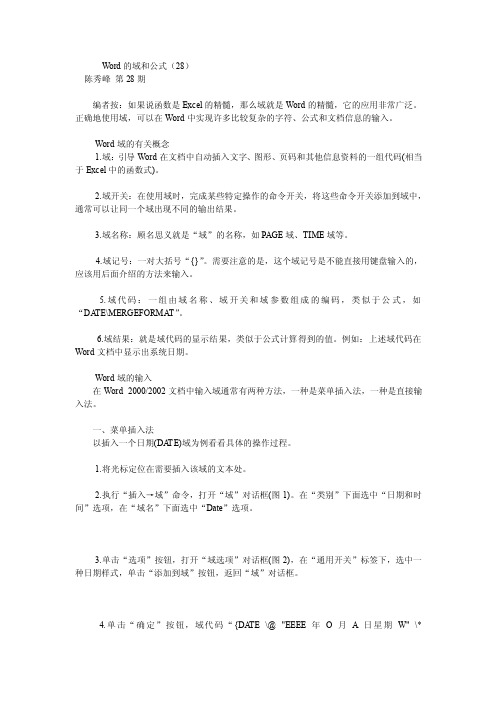
Word的域和公式(28)陈秀峰第28期编者按:如果说函数是Excel的精髓,那么域就是Word的精髓,它的应用非常广泛。
正确地使用域,可以在Word中实现许多比较复杂的字符、公式和文档信息的输入。
Word域的有关概念1.域:引导Word在文档中自动插入文字、图形、页码和其他信息资料的一组代码(相当于Excel中的函数式)。
2.域开关:在使用域时,完成某些特定操作的命令开关,将这些命令开关添加到域中,通常可以让同一个域出现不同的输出结果。
3.域名称:顾名思义就是“域”的名称,如PAGE域、TIME域等。
4.域记号:一对大括号“{}”。
需要注意的是,这个域记号是不能直接用键盘输入的,应该用后面介绍的方法来输入。
5.域代码:一组由域名称、域开关和域参数组成的编码,类似于公式,如“DA TE\MERGEFORMA T”。
6.域结果:就是域代码的显示结果,类似于公式计算得到的值。
例如:上述域代码在Word文档中显示出系统日期。
Word域的输入在Word 2000/2002文档中输入域通常有两种方法,一种是菜单插入法,一种是直接输入法。
一、菜单插入法以插入一个日期(DA TE)域为例看看具体的操作过程。
1.将光标定位在需要插入该域的文本处。
2.执行“插入→域”命令,打开“域”对话框(图1)。
在“类别”下面选中“日期和时间”选项,在“域名”下面选中“Date”选项。
3.单击“选项”按钮,打开“域选项”对话框(图2),在“通用开关”标签下,选中一种日期样式,单击“添加到域”按钮,返回“域”对话框。
4.单击“确定”按钮,域代码“{DA TE \@ "EEEE年O月A日星期W" \*MERGEFORMA T}”即被输入到光标处。
提示:①如果完成上述第2步操作后,直接按下“确定”按钮,即可将系统默认的日期域代码插入到光标处。
②默认情况下,插入的域通常是以“域结果”(如“二○○三年六月十六日星期二”)方式显示在文档中。
《英语写作》课程教学大纲

《英语写作》课程教学大纲课程编码:30613007 学分:4 总学时:72说明【课程性质】英语专业必修课。
【教学目的】提高用英语表达思想的能力。
学生需要了解写作的性质、特点、标准、过程、类型及写作必备的素质,旨在从理论的角度来认识写作这门课程,掌握一些写作技巧,通过大量实践,培养学生写作意识和习惯,帮助学生掌握有关写作的基本信息,提高学生写作能力。
最终要求学生能够用地道的英语写出各种类型的应用文和各种体裁的作文,并且了解和掌握论文写作的各个过程及格式。
【教学任务】研究如何用英语表达思想。
写作涉及的问题很多,除了语言各方面的问题外,还有思想内容和所用材料、组织条理、书写格式等等。
在语言方面,应该注意帮助学生在已有的基础上,不断提高表达思想的准确性与鲜明性,逐渐使他们感觉到英语的极强的表达力,从而喜欢琢磨如何写好文章。
在内容方面,应要求言之有物,观点正确,条理清楚。
在书写格式上,也应有严格的要求。
【教学内容】从最基本的文稿格式开始教授学生掌握英文写作的规则与技巧。
注意措辞,学会如何写出好的句子和好的段落。
提高学生的写作能力,要求学生能够用地道的英语写出各种实用文如便条等和150字左右的小短文。
内容完整,语言简洁流畅,用词准确,克服中国式英语。
同时要求文章结构合理,层次清晰。
最终还必须了解论文写作的五个步骤:选题;收集资料;分析资料、构思、制定提纲;撰写初稿;修改和定稿和特有的格式。
【教学原则与方法】教学原则:理论与实践相结合的原则。
教学方法:教材讲解与作业讲评相结合。
【先修课程要求】本课程为本科二年级学生开设。
学生在第一学年较为全面地学习了语法知识,掌握了一定的词汇量,并具备了一些用英文表达思想的能力,在此基础上修本课程。
【学时分配】教材与主要参考书教材:丁往道《英语写作手册》外语教学研究出版社,1994年。
参考书:Andrew Littlejohn 《剑桥流利英语》写作4 外语教学研究出版社,2000年。
英语分词作用
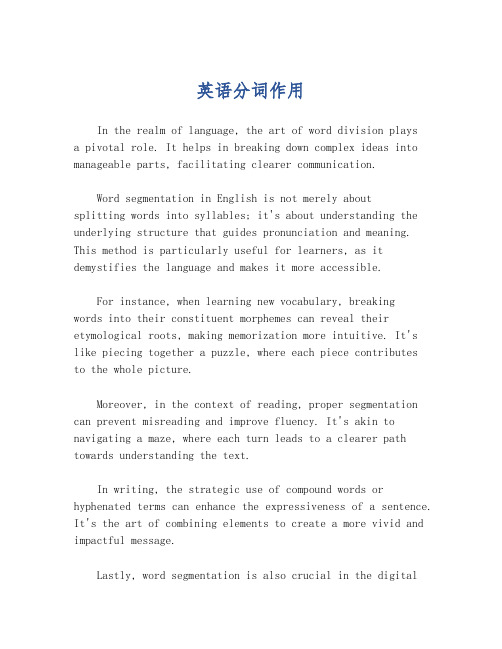
英语分词作用In the realm of language, the art of word division playsa pivotal role. It helps in breaking down complex ideas into manageable parts, facilitating clearer communication.Word segmentation in English is not merely aboutsplitting words into syllables; it's about understanding the underlying structure that guides pronunciation and meaning. This method is particularly useful for learners, as it demystifies the language and makes it more accessible.For instance, when learning new vocabulary, breakingwords into their constituent morphemes can reveal their etymological roots, making memorization more intuitive. It's like piecing together a puzzle, where each piece contributesto the whole picture.Moreover, in the context of reading, proper segmentation can prevent misreading and improve fluency. It's akin to navigating a maze, where each turn leads to a clearer path towards understanding the text.In writing, the strategic use of compound words or hyphenated terms can enhance the expressiveness of a sentence. It's the art of combining elements to create a more vivid and impactful message.Lastly, word segmentation is also crucial in the digitalage, where search engine optimization (SEO) relies on the correct identification of keywords. It's the digital key that unlocks the door to a wider audience.Understanding the function of word segmentation in English is thus essential for anyone looking to master the language, whether it be for academic, professional, or personal purposes. It's the unsung hero that quietly shapes our linguistic experiences.。
- 1、下载文档前请自行甄别文档内容的完整性,平台不提供额外的编辑、内容补充、找答案等附加服务。
- 2、"仅部分预览"的文档,不可在线预览部分如存在完整性等问题,可反馈申请退款(可完整预览的文档不适用该条件!)。
- 3、如文档侵犯您的权益,请联系客服反馈,我们会尽快为您处理(人工客服工作时间:9:00-18:30)。
7) Divide words with prefixes or suffixes between the prefix or suffix and the rest part of the word: un·like, re·inforce·ment, un·like, re·inforce·ment, un·expect·ed. 8) Do not divide the last word on the next page. If there is not enough space for a sentence left at the last line of the page, you should write the whole sentence on the next page. 9) Avoid dividing proper names of people or places, like Fran·ce, Jordan, R. · R.
2. Word Division
1) 1. Never divide one-syllable words such as onethrough, space, break and rush. rush. 2) Do not put a single letter of a word at the end or at the beginning of a line, even if that single letter makes up a syllable, such as a·cute, hand· hand·y. 3) Do not put a two-letter syllable at the twobeginning of a line: stat·ed, period·ic. 4) Do not make divisions in a way that may cause confusion to the reader: tax·is, leaf·let, plea·sant.
5) Divide hyphenated words only at the hyphen: kindkind-hearted, self-respect, son-in-law. selfson-in6) ds with double twoconsonants between two consonants: bat·ter, smug·gle. smug·gle.
